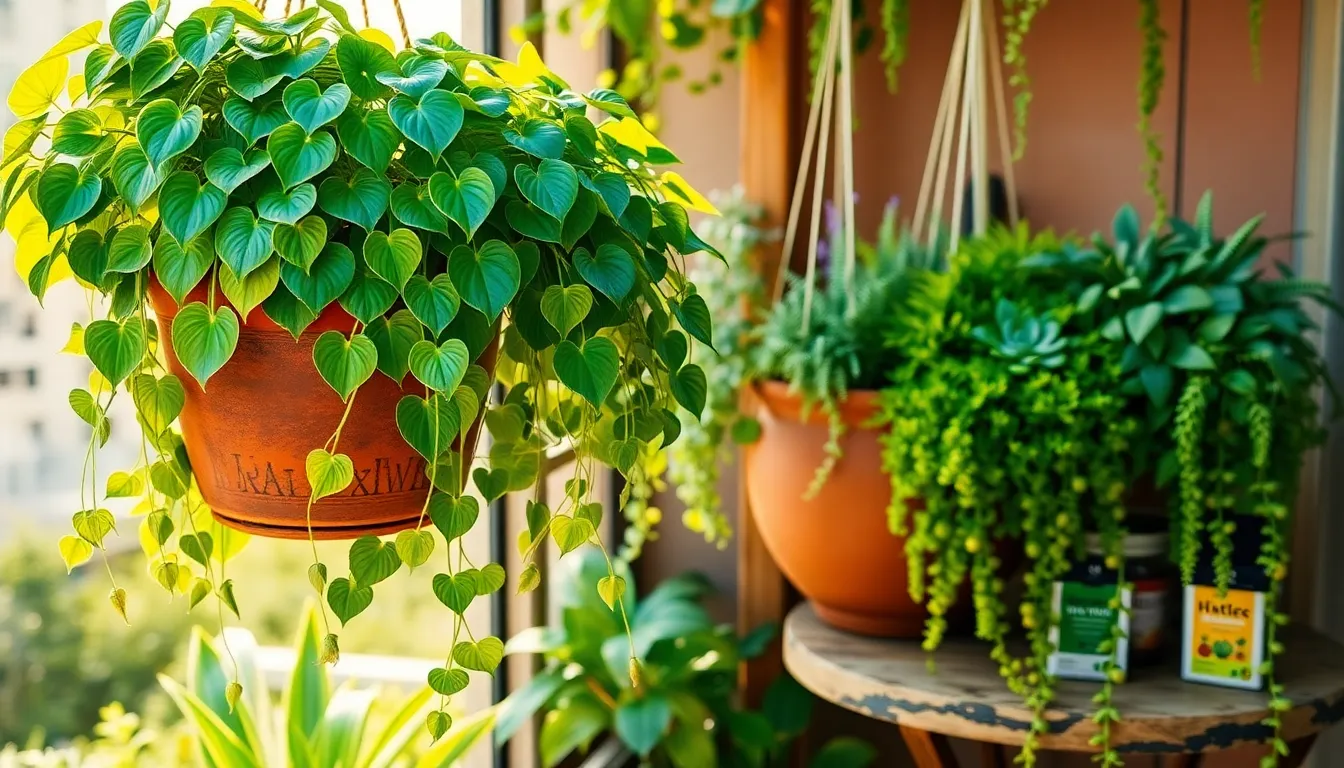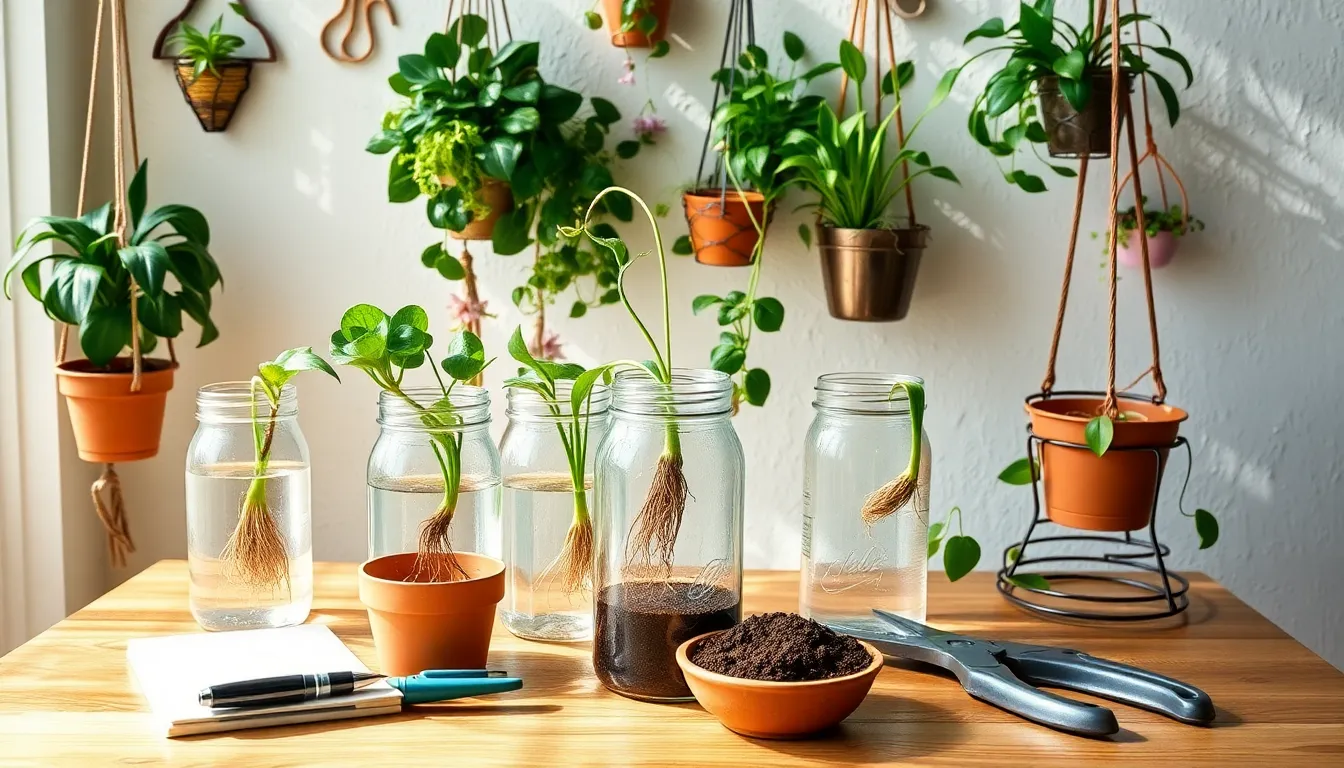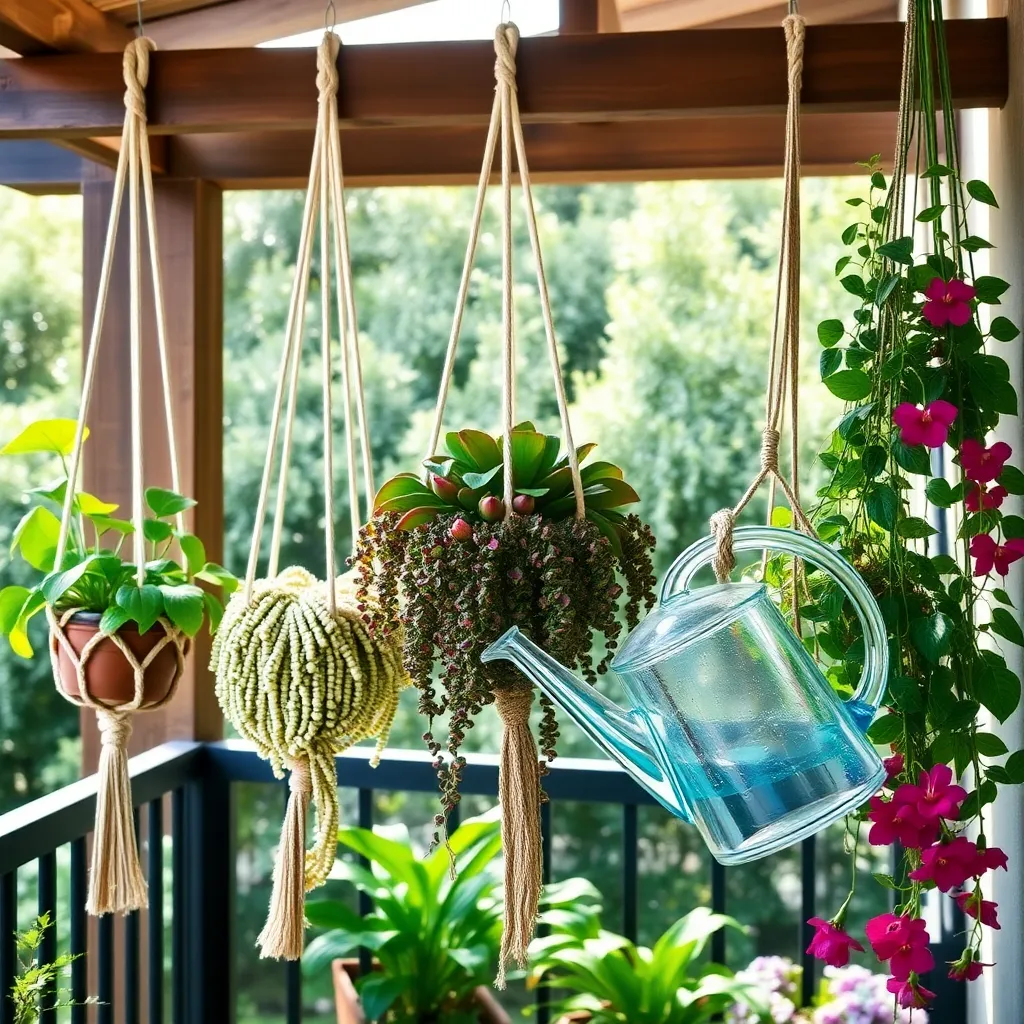Imagine stepping into your home or garden and being greeted by a cascade of vibrant colors, each plant suspended in mid-air like a natural chandelier. Whether you’re a novice gardener just beginning to explore the joys of plant care or a seasoned green thumb looking to add a touch of whimsy to your space, hanging plants offer a delightful way to infuse life and color into any environment. These living ornaments not only brighten your surroundings but also invite a sense of tranquility and joy that only nature can provide.
Hanging plants are more than mere decoration; they are a testament to the beauty and adaptability of nature. In this article, we will explore a diverse selection of 20 colorful hanging plants that will transform your space into a vibrant oasis. You’ll discover plants that thrive in various conditions, offering you the flexibility to choose the perfect match for your light and space constraints. From the cascading beauty of trailing vines to the striking hues of flowering baskets, each plant comes with its own unique charm and care requirements.
As you delve into the world of hanging plants, you’ll learn practical tips for selecting, planting, and maintaining these botanical beauties with confidence. We aim to equip both beginners and seasoned gardeners with the knowledge needed to make informed choices and cultivate flourishing plants. Whether you’re looking to create an indoor sanctuary or enhance your outdoor garden, the possibilities with hanging plants are as boundless as your imagination. By the end of this journey, you’ll be ready to elevate your garden to new heights, literally and figuratively, with the enchanting allure of hanging plants.
Choosing Vibrant Hanging Plants
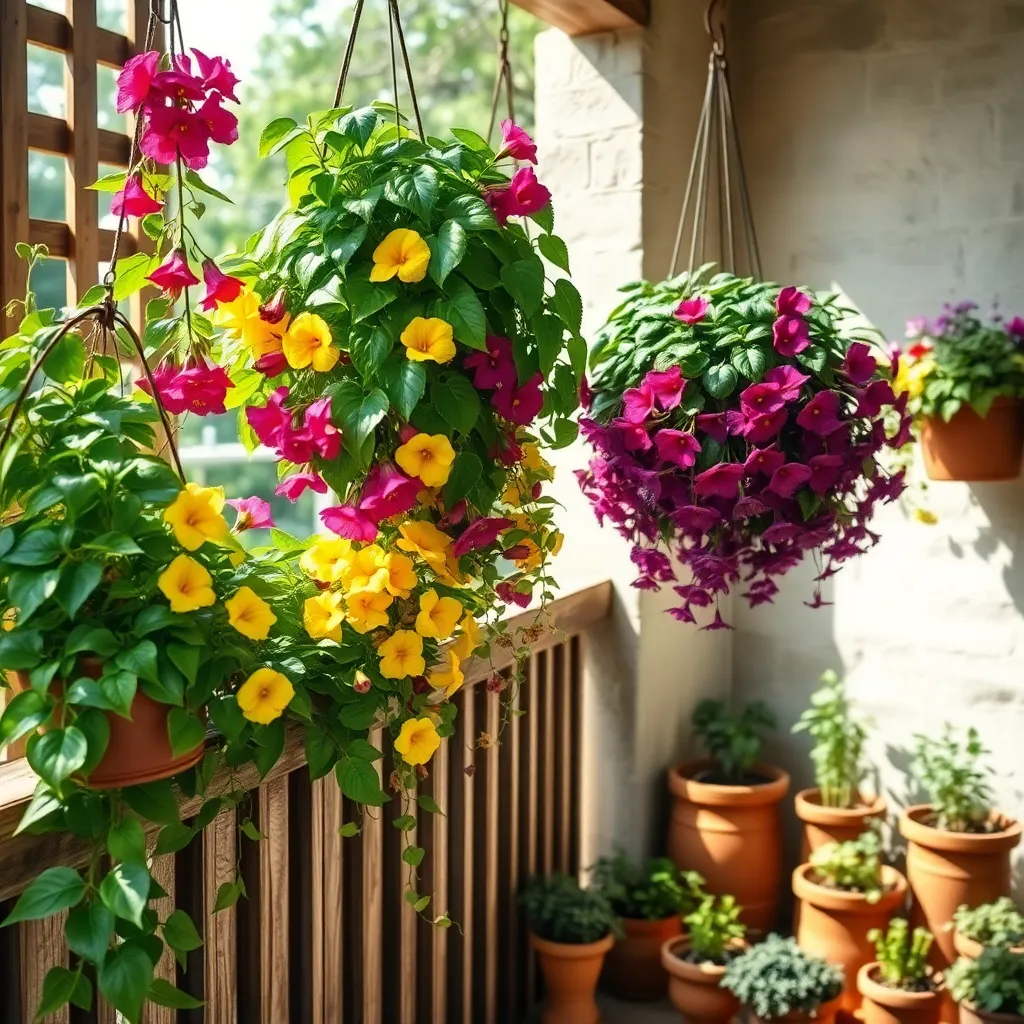
Choosing vibrant hanging plants can transform your space into a lively and colorful sanctuary. Begin by selecting plants that thrive in your specific environment, considering factors like light levels and temperature.
Light is a crucial factor in plant health, so assess the available sunlight in the area where you plan to hang your plants. Some plants, like the fuchsia, flourish in partial shade, while others, such as trailing petunias, require full sun for the best blooms.
When it comes to soil, opt for a well-draining potting mix to prevent root rot, which is a common issue in hanging planters. Adding perlite or sand to standard potting soil can improve drainage and keep your plants healthy.
Watering needs will vary depending on the plant species and the growing conditions. Generally, hanging plants need more frequent watering since they tend to dry out faster; check the soil moisture level regularly and water when the top inch feels dry.
For those looking to add a pop of color, consider plants like the vibrant lantana or the cascading blooms of calibrachoa. These species not only provide a burst of color but also attract pollinators like butterflies and hummingbirds, adding dynamic life to your space.
Advanced gardeners might experiment with mixing different plant species in one hanging basket to create a lush, multi-textured display. Ensure compatibility in terms of water and light needs to maintain a harmonious plant arrangement.
Top Picks for Indoor Hanging
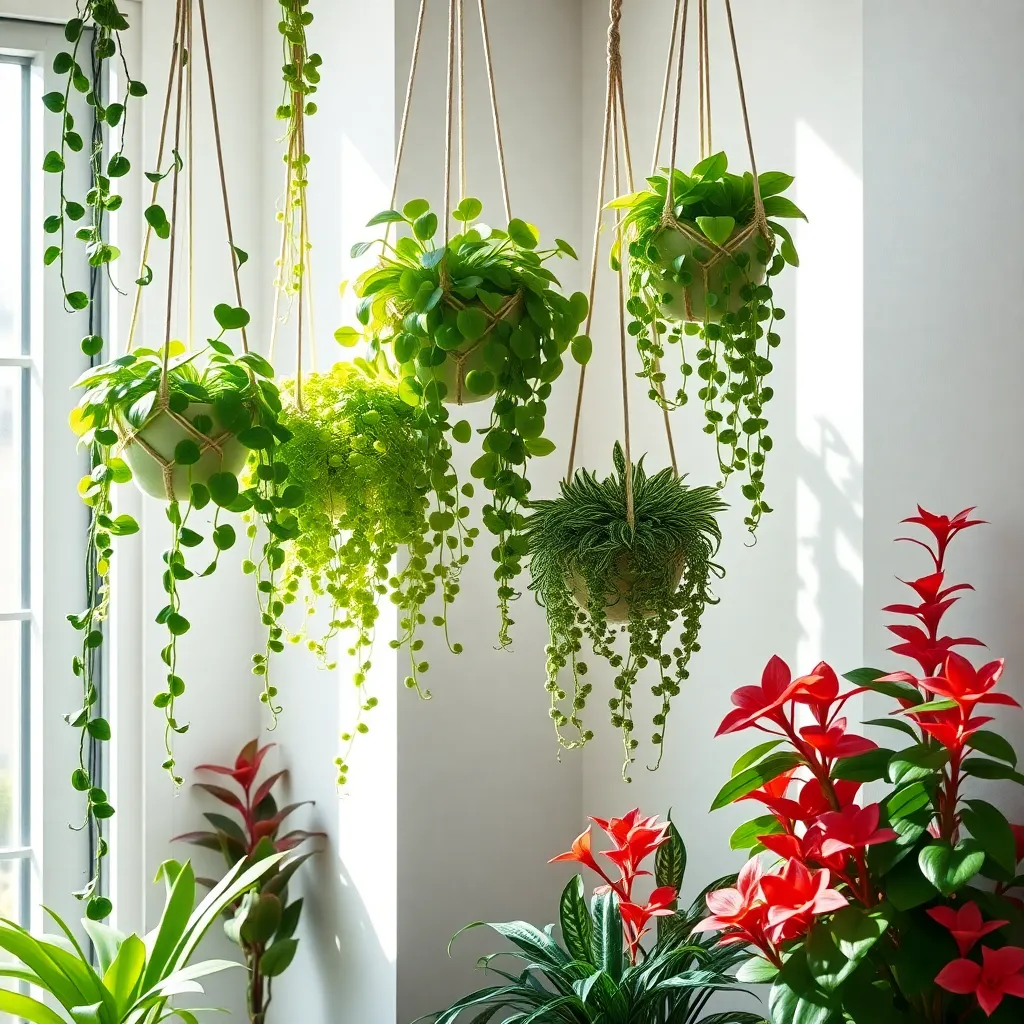
When selecting indoor hanging plants, it’s essential to consider the lighting conditions in your space. Most hanging plants thrive in bright, indirect light, but some can adapt to lower light levels, making them versatile for various home setups.
Start with the ever-popular spider plant, known for its arching leaves and ease of care. To keep it healthy, water it once the top inch of soil feels dry, and use a well-draining potting mix to prevent root rot.
For a splash of color, consider the vibrant purple heart plant, which boasts striking purple leaves. This plant prefers a sunny spot and requires weekly watering, allowing the soil to dry out slightly between waterings.
Another excellent choice is the trailing pothos, which is perfect for beginners due to its forgiving nature. It can thrive in a variety of lighting conditions and benefits from a monthly dose of liquid fertilizer to promote lush growth.
For those who enjoy a challenge, try growing a string of pearls, known for its unique bead-like foliage. This succulent requires bright light and minimal watering, making it ideal for a sunny spot with good air circulation.
To promote healthy hanging plants, ensure they have drainage holes to prevent waterlogging. Consider placing a saucer beneath your pots to catch excess water, and periodically check for any signs of pests or disease to address issues promptly.
Colorful Plants for Outdoor Spaces
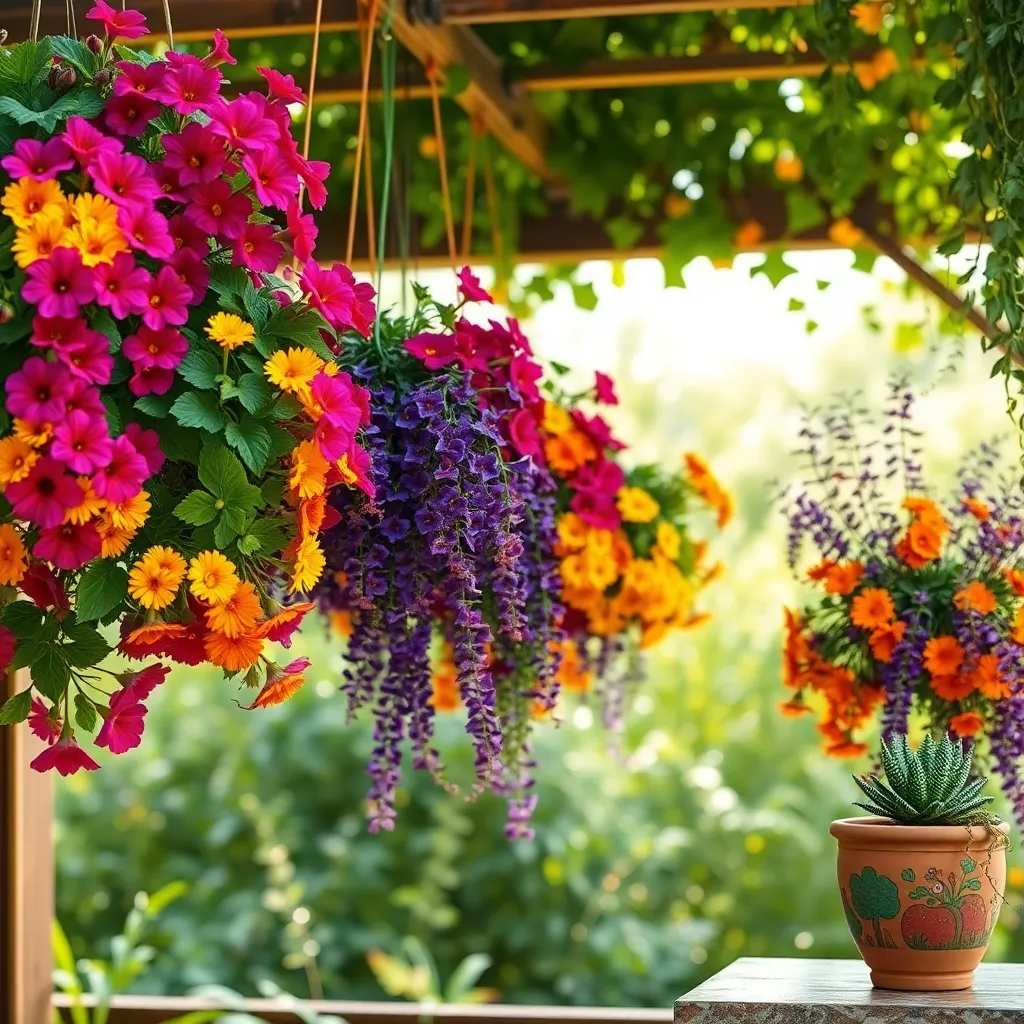
Brightening up your outdoor spaces with colorful hanging plants can transform your garden into a vibrant oasis. Consider planting fuchsia, known for its brilliant blooms that come in shades of pink, purple, and red. Fuchsias require well-draining soil and benefit from a mix of perlite and peat moss to maintain moisture without waterlogging. Ensure they receive partial shade to protect them from harsh midday sun, which can scorch their delicate flowers.
Another excellent choice is the trailing lobelia, which offers cascading blue or white flowers that gracefully spill over the edges of hanging baskets. Lobelias thrive in moist, fertile soil with a pH between 6.0 and 7.0, so adding organic compost can be beneficial. They prefer cooler temperatures, so placing them in a spot that receives morning sun and afternoon shade will help them flourish. Regular deadheading will encourage continuous blooming throughout the season.
For a pop of fiery color, consider planting calibrachoa, often referred to as “million bells,” which produces an abundance of small, petunia-like flowers. These plants thrive in full sun and need at least six hours of sunlight daily to maintain their bright colors. Use a balanced liquid fertilizer every couple of weeks to support their vigorous growth and abundant flowering. Pinching back the stems can also promote bushier growth and prevent legginess.
Creating a stunning display of colorful hanging plants is not only achievable but also immensely rewarding. Incorporate a mix of plants that offer varied colors and textures to add depth to your garden design. By understanding each plant’s specific needs and providing appropriate care, you can enjoy a continuous splash of color that enhances your outdoor living space. Remember to check soil moisture regularly and adjust watering schedules based on seasonal changes to ensure healthy and thriving plants.
Best Low-Maintenance Options

For gardeners seeking low-maintenance hanging plants, the Spider Plant is an excellent choice. It thrives in indirect light and only requires watering when the soil dries out, making it perfect for busy schedules.
Another hardy option is the Pothos, which is known for its vigorous growth and ability to tolerate low light conditions. Watering once the top inch of soil feels dry will keep your Pothos lush and vibrant.
Consider the Boston Fern if you want to add a touch of lush greenery with minimal effort. While it prefers humid environments, it can adapt well to less humid homes; simply mist the leaves regularly.
For those looking to add a pop of color, the Trailing Lobelia is a fantastic option that blooms profusely with little care. Ensure it receives partial sunlight and water consistently to keep it blossoming throughout the season.
Enhancing Small Spaces with Plants

Maximizing small spaces with plants can transform even the tiniest nook into a vibrant oasis. Begin by choosing compact, colorful hanging plants that thrive in confined environments, such as fuchsias or trailing lobelias.
For optimal growth, ensure your chosen plants receive adequate light by positioning them near windows or under grow lights. Hanging planters with built-in water reservoirs can help maintain consistent moisture levels, reducing watering frequency.
Soil choice is crucial for hanging plants; opt for a light, well-draining potting mix to prevent root rot. Add perlite or sand to your soil mix to enhance drainage, especially for plants like petunias that prefer slightly drier conditions.
To keep your small space visually appealing, consider a variety of plant colors and textures. Mixing plants like the cascading golden pothos with the bold flowers of calibrachoa can create a visually stunning display.
Sunlight Requirements for Each Plant
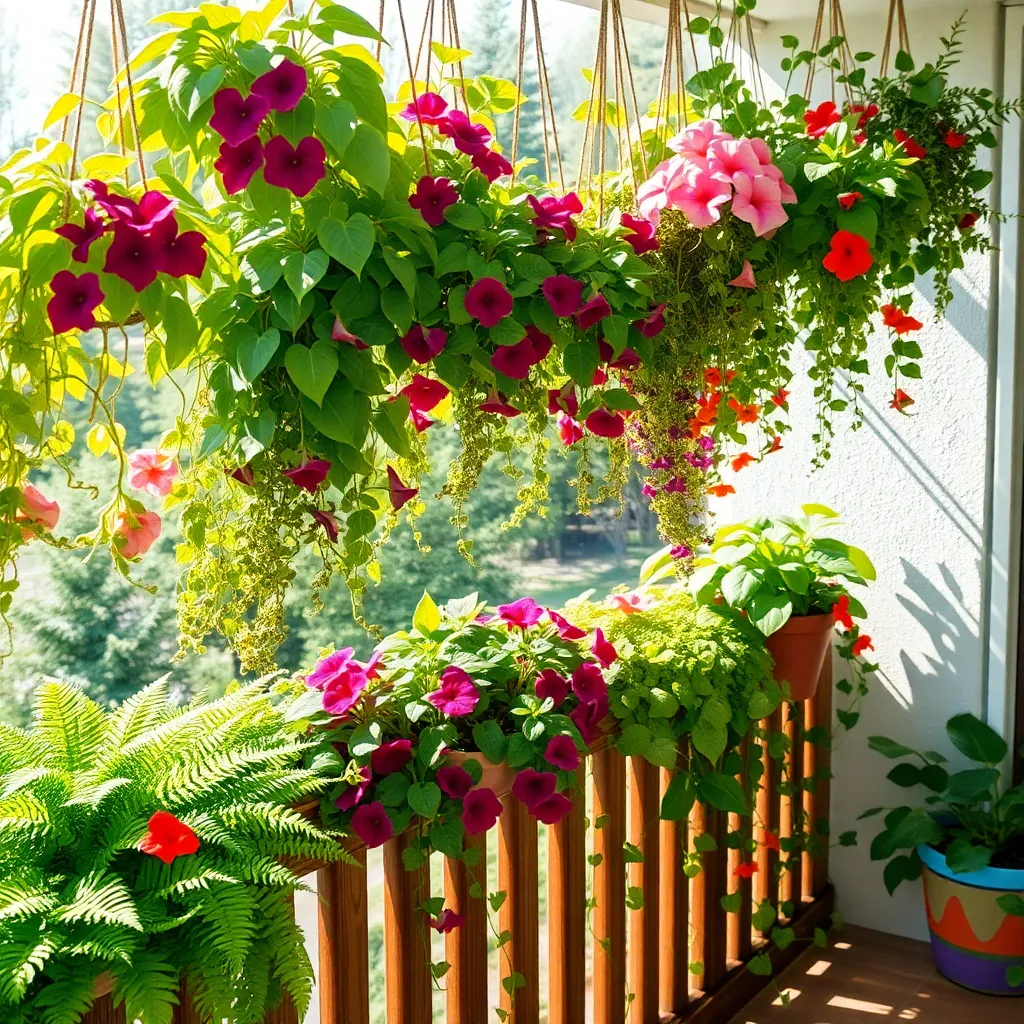
Some hanging plants thrive in full sunlight, while others prefer shadier spots. Understanding the sunlight needs of each plant is crucial for their health and vibrant colors.
For example, petunias require at least six hours of direct sunlight daily to bloom optimally. Make sure to place them in a south-facing window or outdoor area where they can soak up plenty of sun.
On the other hand, plants like ferns do better in indirect light. You might consider hanging them in a bright room, away from direct sun, to avoid leaf scorch.
Another popular choice, begonias, prefer filtered light and can tolerate some morning sun. Be careful not to expose them to harsh afternoon rays, as this can damage their delicate foliage.
For those with limited sunny spots, English ivy is a great option, as it thrives in low to medium light. Ensure it receives some indirect light throughout the day to maintain its vibrant green hue.
Understanding these light requirements will help ensure your hanging plants not only survive but truly thrive. Adjust their placement as needed to cater to their specific sunlight preferences, and you’ll be rewarded with colorful, lush displays.
Ideal Soil for Hanging Plants
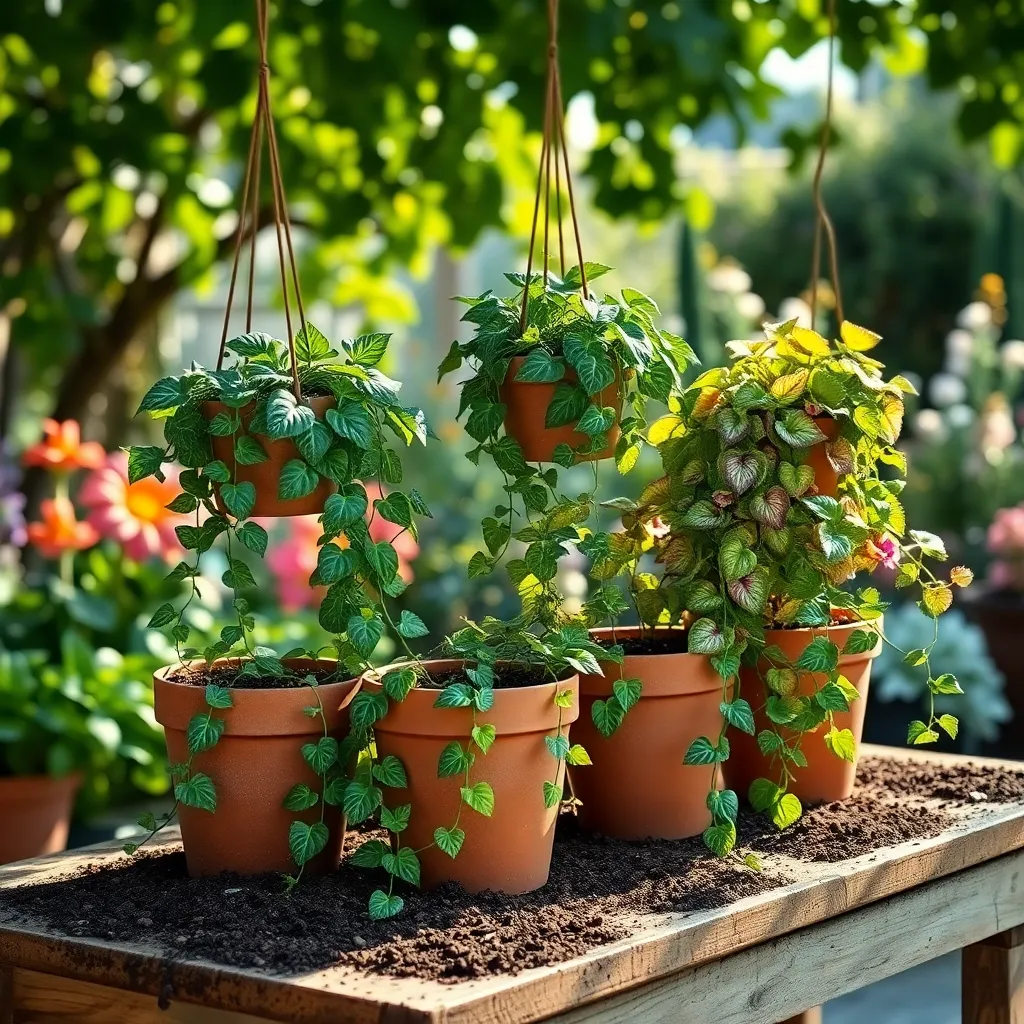
For hanging plants to thrive, using the right soil is crucial for their health and vibrancy. A well-draining potting mix is essential, as it prevents root rot by allowing excess water to escape easily.
Consider using a mix that includes components like peat moss, perlite, or vermiculite, which improve aeration and drainage. Adding coconut coir can help retain moisture while still allowing air to circulate around the roots.
Beginners can start with a pre-mixed potting soil formulated for hanging baskets, widely available at garden centers. For those looking to experiment, creating a custom blend by mixing equal parts peat moss, perlite, and quality compost can offer enhanced nutrient availability.
It’s important to monitor the moisture level of your hanging plants as they tend to dry out faster than ground plants. Watering frequency may need to increase during hot and windy conditions, while in cooler weather, less frequent watering will suffice.
Watering Guidelines and Tips
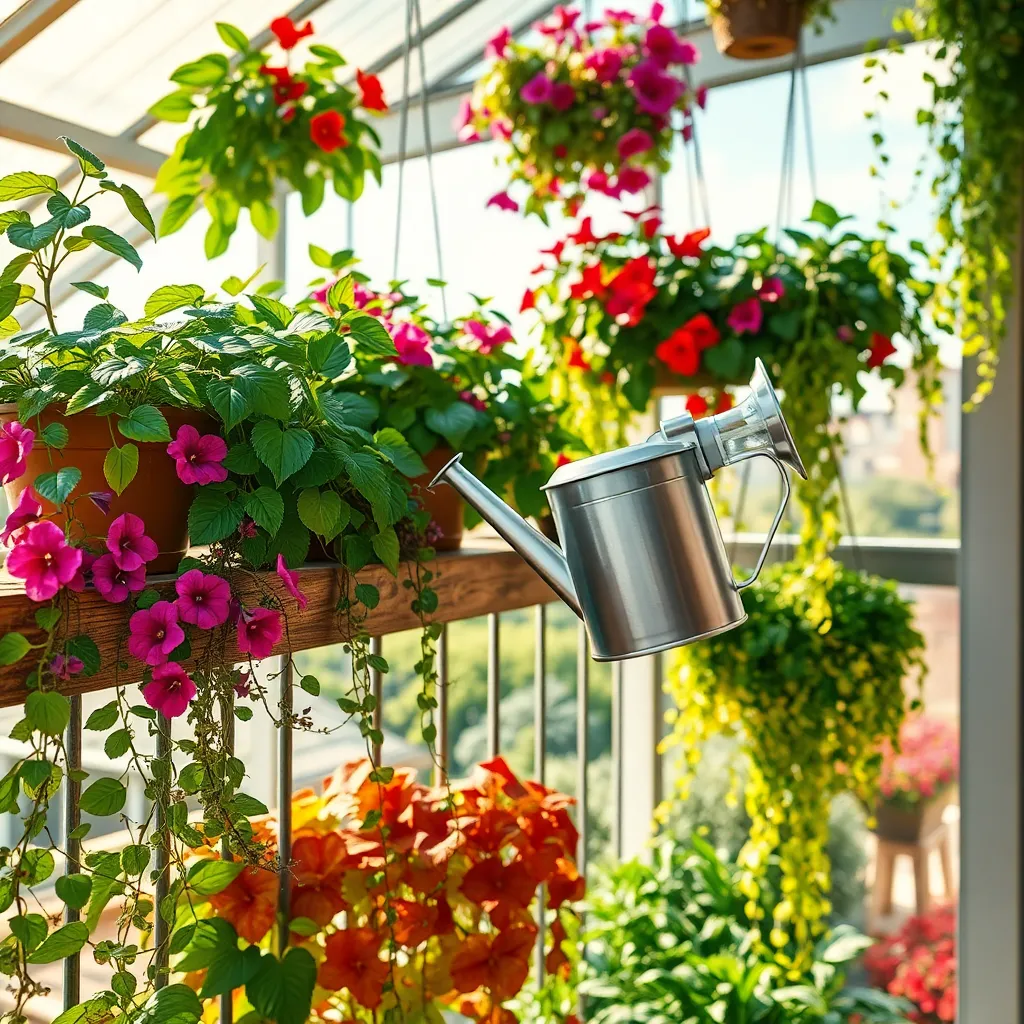
Watering is a crucial aspect of caring for hanging plants, as their elevated position can cause them to dry out more quickly than ground plants. It’s essential to check the moisture level of the soil regularly by inserting your finger about an inch deep; if it feels dry, it’s time to water.
Consider watering your hanging plants early in the morning or late in the afternoon to prevent rapid evaporation. Aim to water thoroughly until you see it draining from the bottom, ensuring the entire root ball is moistened.
For a more advanced approach, use self-watering pots or add a moisture-retaining product like water crystals to the soil mix. This can help maintain consistent moisture levels, reducing the frequency with which you need to water.
Be mindful of the specific needs of your plant species, as some, like the brightly colored Bougainvillea, prefer slightly drier conditions between waterings. Meanwhile, plants like Fuchsia thrive best in consistently moist, but not soggy, soil.
Fertilizing for Vibrant Growth
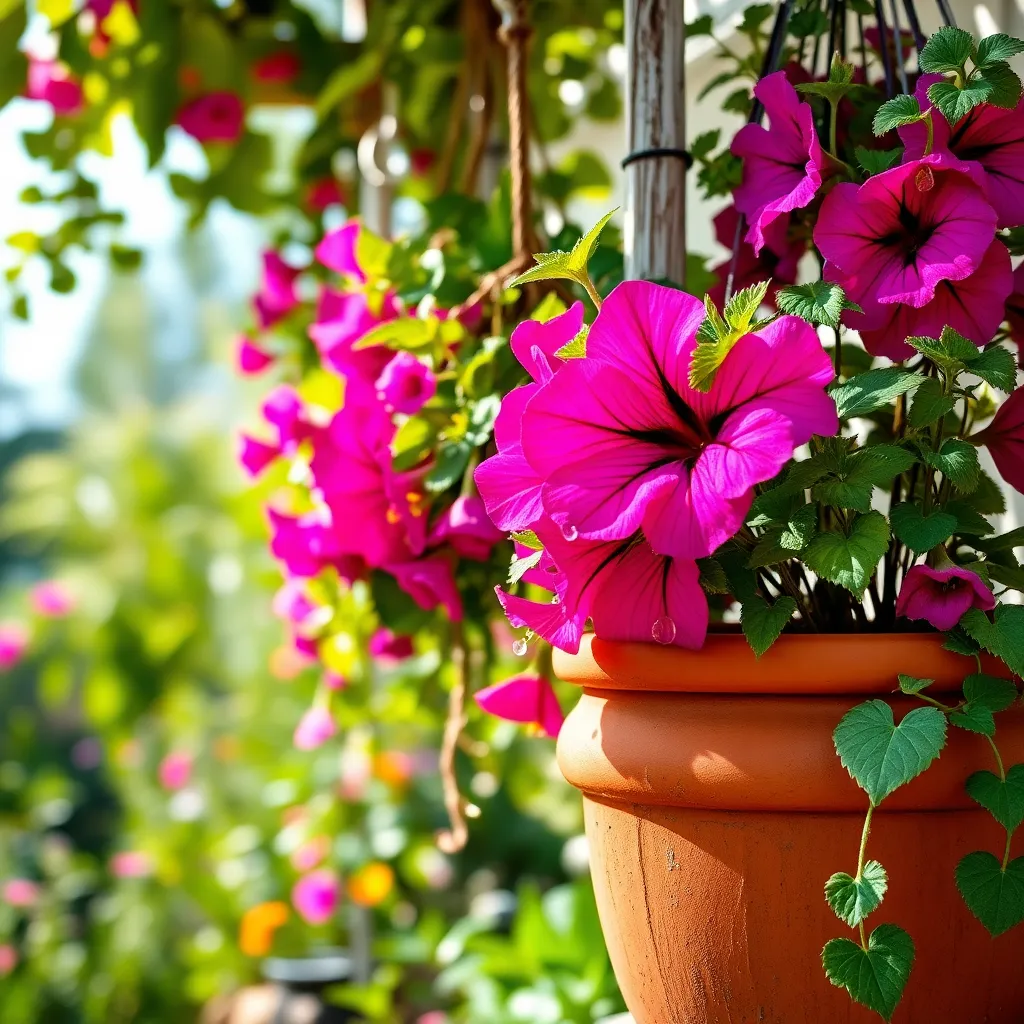
To keep your hanging plants thriving, proper fertilization is key to ensuring vibrant growth. Apply a balanced, water-soluble fertilizer every two weeks during the growing season, ensuring the nutrients reach all parts of the plant.
Choose a fertilizer with a balanced ratio, such as 10-10-10, to provide equal amounts of nitrogen, phosphorus, and potassium. These essential nutrients encourage lush foliage, robust roots, and abundant blooms.
For an eco-friendly option, consider using organic fertilizers like fish emulsion or seaweed extract, which are gentle and add beneficial microorganisms to the soil. These natural products not only nourish your plants but also improve soil structure and fertility over time.
Advanced gardeners might opt for slow-release fertilizers, which gradually supply nutrients over several months, reducing the need for frequent applications. Ensure that the fertilizer you choose is suitable for the specific type of plant you are growing, as some plants may have unique nutrient requirements.
Pruning Techniques for Hanging Plants

When it comes to hanging plants, pruning is essential for maintaining their shape and promoting healthy growth. Begin by identifying any dead or damaged branches, as these should be removed promptly to prevent disease.
Consider the overall form of your hanging plant, trimming back overgrown branches to maintain a balanced appearance. Regular pruning encourages new growth, which can lead to a fuller and more vibrant display.
For those new to gardening, a pair of clean, sharp scissors is often sufficient for most hanging plants. However, experienced gardeners might prefer using pruning shears for a more precise cut, especially on thicker stems.
Remember to sterilize your tools before use to avoid transferring any diseases between plants. A simple solution of water and rubbing alcohol works well for this purpose.
An advanced tip is to prune during the plant’s growing season, typically spring and early summer, which allows it to recover quickly. For trailing varieties, consider pinching back the tips to encourage bushier growth.
Pest Management Strategies
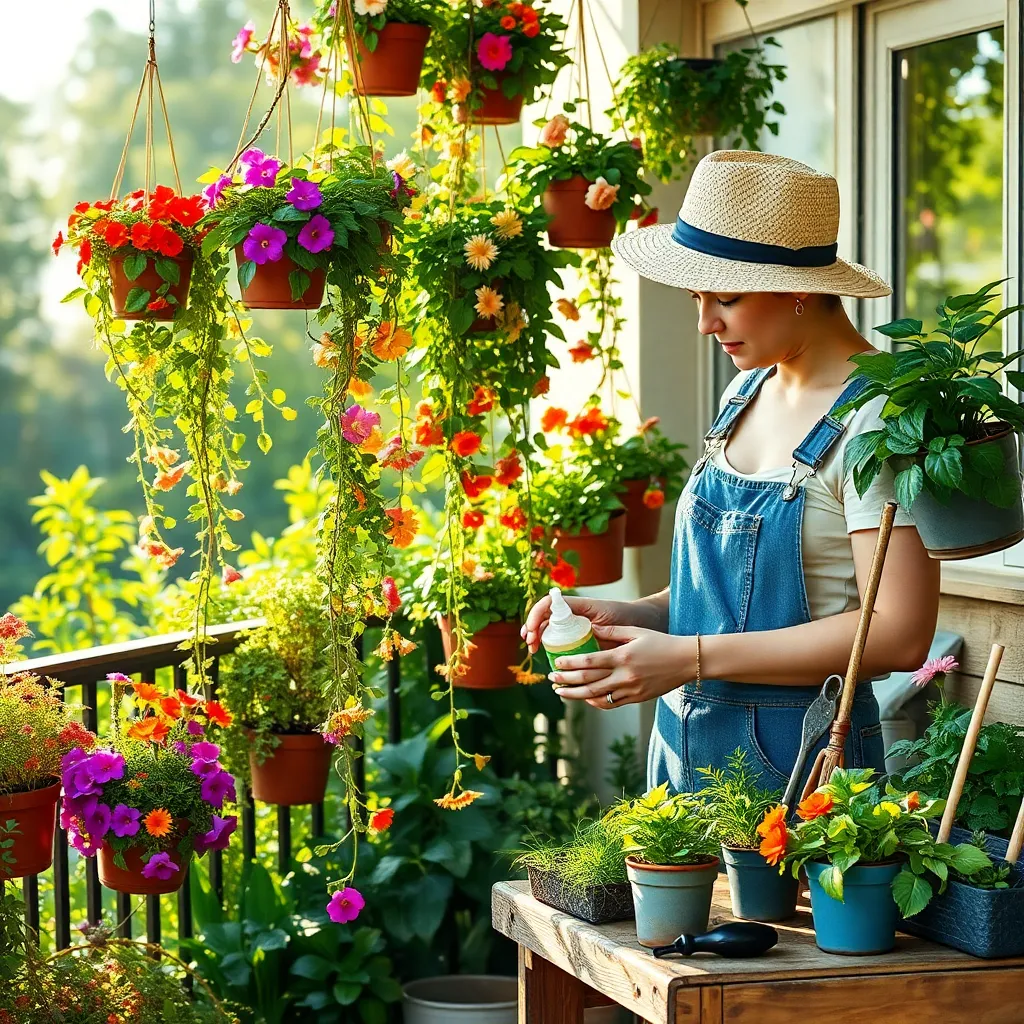
When managing pests in your colorful hanging plants, it’s crucial to start by identifying the specific pests causing issues. Common culprits include aphids, spider mites, and whiteflies, which can all be managed with a keen eye and timely intervention.
Implementing a regular inspection routine is an effective strategy in pest management. By checking your plants weekly, you can catch infestations early, allowing for swift action before the pests cause significant damage.
Natural remedies often work wonders in maintaining plant health without resorting to harsh chemicals. For instance, spraying a mixture of water and mild dish soap can help control aphids by suffocating these soft-bodied insects without harming the plant.
For those looking to minimize chemical use, introducing beneficial insects like ladybugs or predatory mites can help maintain a healthy balance. These natural predators feed on common pests, providing an environmentally friendly option for pest control.
Consider using neem oil as a versatile pest management tool. This natural pesticide can be applied as a foliar spray to deter a variety of pests while being gentle on your plants.
Finally, maintaining optimal plant health through proper watering and fertilizing can reduce pest infestations. Healthy plants are more resilient and less attractive to pests, making consistent care a key element of your pest management strategy.
Creative Hanging Display Ideas

Enhancing your space with hanging plant displays can be both fun and rewarding. Consider using macramé hangers to add a touch of artistry, while ensuring your plants are securely supported.
For a vibrant display, try layering different plants within a single hanging setup. Mix trailing and upright plants like pothos and spider plants for a dynamic and colorful effect.
If you’re short on space, think vertically by attaching wall-mounted brackets to hang your plants. This method not only saves space but also draws the eye upwards, creating a sense of height in your room.
When selecting plants for your hanging displays, opt for those that thrive in well-draining soil to prevent root rot. Ferns and succulents are excellent choices, given their adaptability to varied lighting conditions.
DIY Hanging Planter Projects
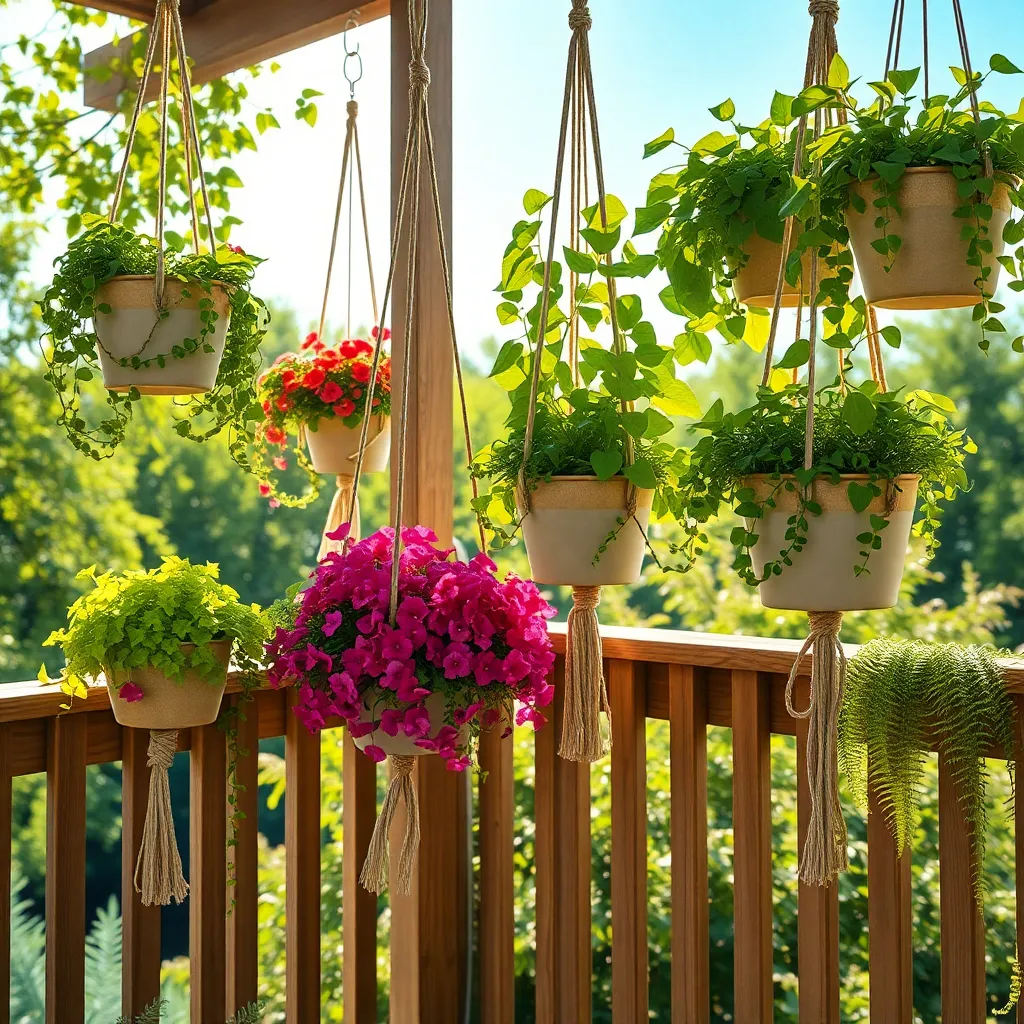
Creating your own hanging planters is a fun and rewarding project that adds a personal touch to your garden or home. Start by selecting a sturdy container, such as a recycled plastic bottle or a wooden box, ensuring it has drainage holes to prevent waterlogging.
For a basic project, consider using macramé to craft a decorative hanger for your planter. Choose a rot-resistant cord like nylon or polyester to ensure longevity, and follow a simple knot pattern to create a stylish yet functional holder.
Plant selection is crucial for successful hanging planters. Opt for lightweight, trailing plants like spider plants or pothos that thrive in well-draining soil and require minimal maintenance.
Advanced gardeners might experiment with creating a vertical herb garden using tiered hanging baskets. Ensure each basket has good sun exposure and use a light, nutrient-rich potting mix to support rapid growth and abundant harvests.
Seasonal Care for Hanging Plants
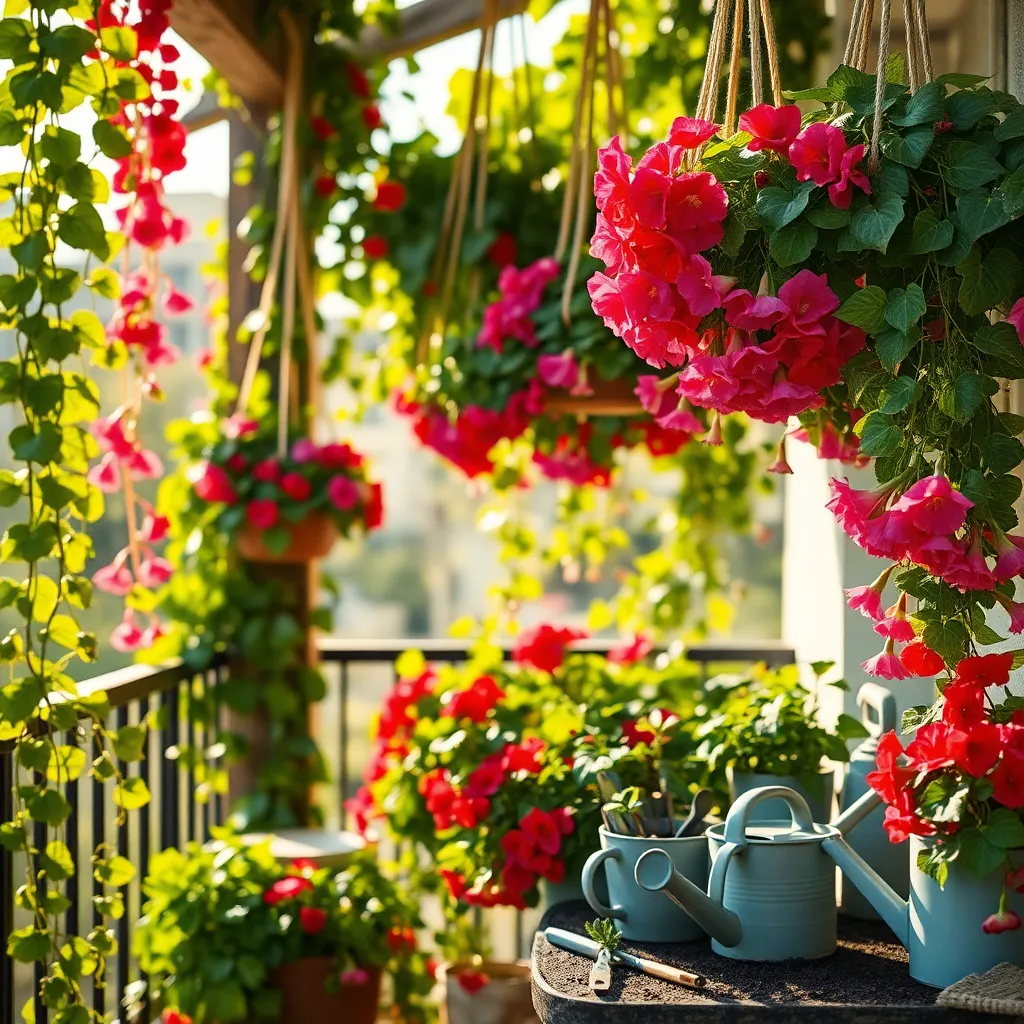
Hanging plants require distinct care as the seasons change to thrive and remain vibrant. In spring, it is crucial to gradually reintroduce your hanging plants to outdoor conditions if they were indoors during winter.
During summer, consider increasing the watering frequency because hanging plants typically dry out faster. Ensure your plants receive adequate sunlight, but if the sun is too harsh, provide some shade to prevent leaf burn.
Autumn is the perfect time to prepare your plants for the cooler months ahead by reducing watering and applying a balanced fertilizer. Pruning dead or damaged foliage helps maintain the plant’s health and encourages new growth in the coming spring.
In winter, if your climate is cold, bring your hanging plants indoors to protect them from frost. Maintain a consistent temperature and reduce watering, as plants generally grow slower during this time and require less moisture.
Combining Plants for Color Harmony

Creating color harmony in your hanging plant arrangements can transform any space into a vibrant oasis. Start by selecting a color palette that suits your personal style or complements the surroundings, such as using analogous colors like shades of green, blue, and purple for a calming effect.
When choosing plants, consider their natural bloom colors and foliage shades to ensure a harmonious combination. For example, pairing the bright green foliage of Spider Plants with the deep purple blooms of Petunias can create a striking contrast that draws the eye.
It’s crucial to match plant species with similar care requirements to ensure all thrive together. Most hanging plants prefer well-draining soil, so consider a mix of peat, perlite, and a touch of sand for a balanced medium that supports diverse plant needs.
For those more experienced, experiment with multi-layered arrangements by incorporating plants of different heights and textures. This not only adds depth but also allows each plant’s unique coloration to shine, creating a dynamic visual experience.
Unique Varieties to Consider
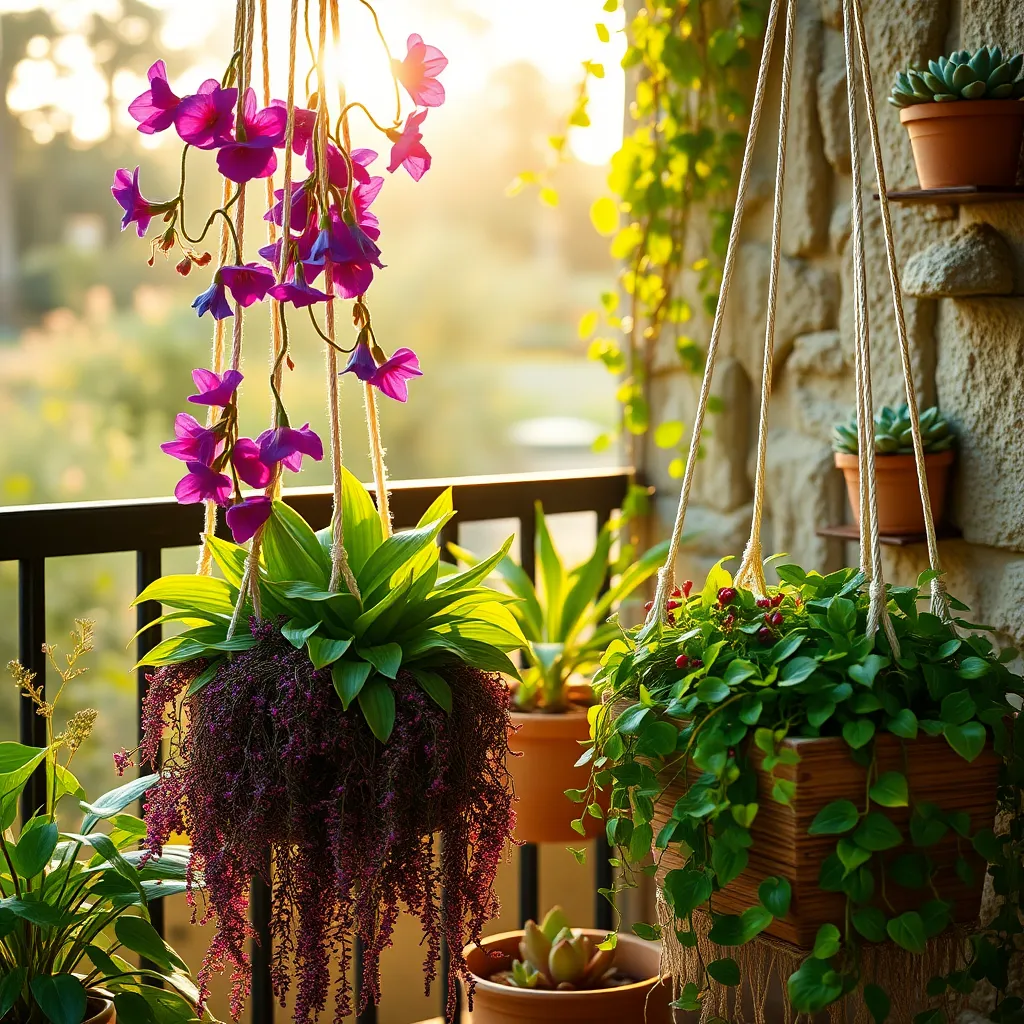
Consider adding the striking Streptocarpus ‘Cape Primrose’ to your hanging plant collection. This unique variety thrives in bright, indirect light and requires a well-draining potting mix to prevent root rot.
Another fascinating option is the Trailing Lobelia, known for its vivid blue flowers that cascade beautifully from baskets. Ensure the soil remains consistently moist, and feed it with a balanced liquid fertilizer every two weeks during its growing season for optimal blooms.
For those looking to add a touch of exotic flair, the String of Bananas offers an unusual look with its banana-shaped foliage. It prefers a sandy, well-draining soil and should be watered thoroughly but infrequently, allowing the soil to dry out between waterings.
Novice gardeners will appreciate the resilient Spider Plant, which is perfect for hanging baskets. It adapts well to various lighting conditions and requires minimal care, thriving in a general-purpose potting mix with regular watering when the top inch of soil feels dry.
Cascading Plants for Dramatic Effect
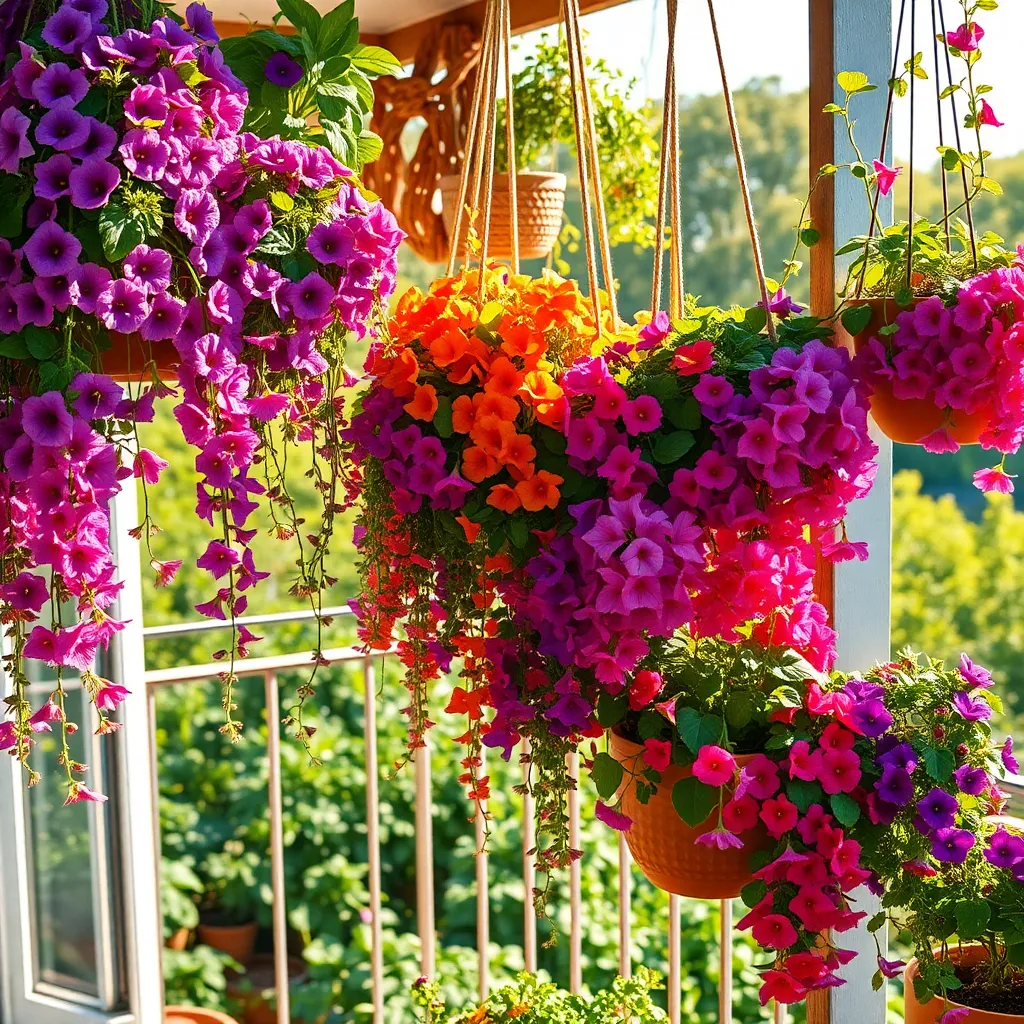
Cascading plants can transform any hanging basket into a stunning visual display, adding both depth and intrigue. For beginners, consider starting with trailing varieties like the classic sweet potato vine (Ipomoea batatas), which is known for its vigorous growth and vibrant foliage.
Ensure your cascading plants receive the right amount of sunlight, as this is crucial for their development. Most trailing plants thrive in full to partial sunlight, so positioning them in a spot where they can soak up the rays for at least six hours a day is ideal.
Watering is another critical factor in maintaining healthy cascading plants. Check the soil moisture regularly by inserting your finger about an inch deep into the soil; if it feels dry, it’s time to water.
Advanced gardeners might want to experiment with mixing different cascading plants in a single basket for a layered effect. Pairing contrasting foliage, such as the silver leaves of Dichondra ‘Silver Falls’ with the bright hues of trailing petunias, can create a dynamic arrangement.
Maximizing Space with Vertical Gardens
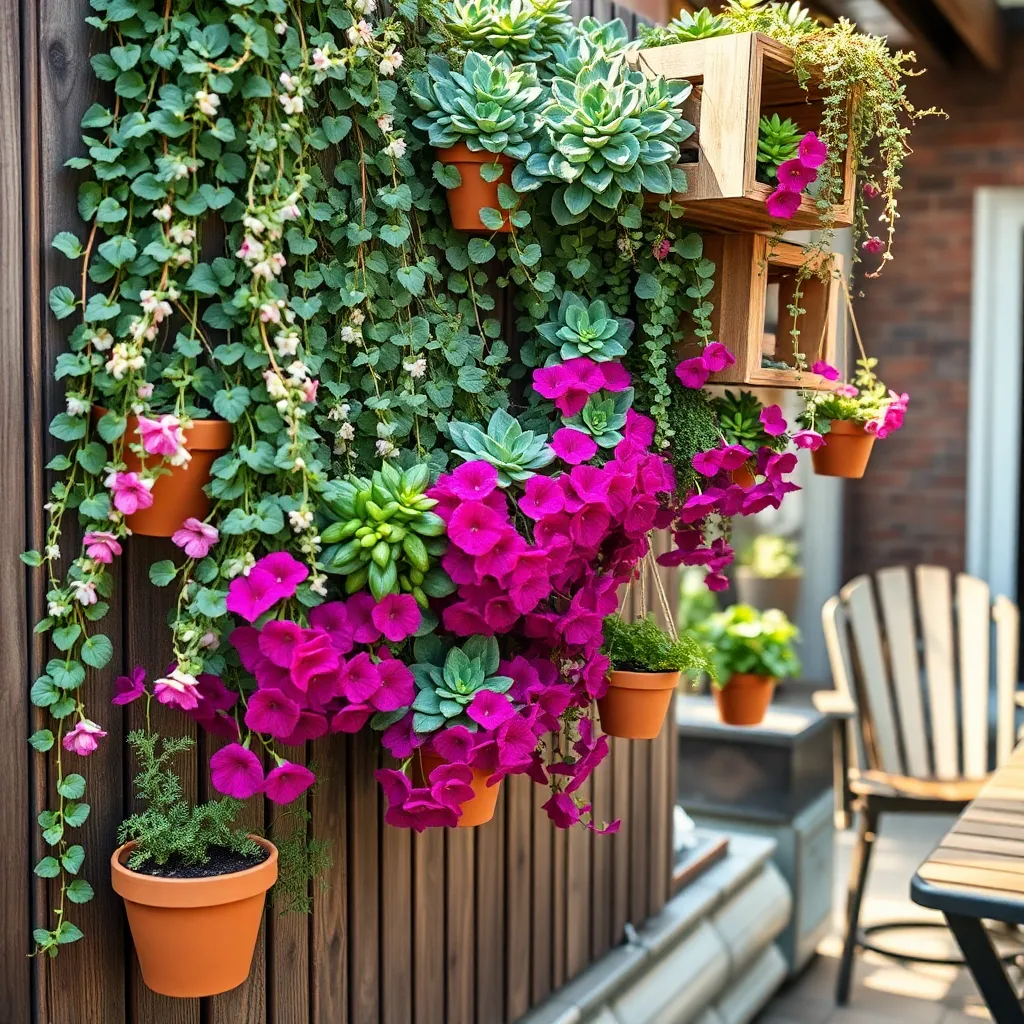
To transform your garden into a vertical oasis, begin by selecting a sturdy vertical structure, such as a trellis or wall-mounted planters. Ensure these structures are securely anchored and capable of supporting the weight of fully grown plants.
Consider using lightweight materials like coco coir or sphagnum moss as your growing medium, especially in wall planters. These materials provide excellent drainage and aeration, crucial for healthy root development.
When choosing plants, opt for species known for their vertical growth habits, such as climbing roses or jasmine. These plants naturally adapt to vertical spaces and can create stunning displays with minimal horizontal spread.
It’s essential to tailor your watering routine to the vertical setup, as water tends to flow downward, leaving top layers dry. Installing a drip irrigation system can ensure even moisture distribution, effectively reducing maintenance time.
For a splash of color, incorporate flowering vines like clematis or passionflower, which thrive in vertical environments. Regular pruning will encourage dense foliage and maintain the desired shape, enhancing the visual impact of your vertical garden.
- Use a balanced liquid fertilizer monthly to support vigorous growth.
- Monitor for pests such as aphids, especially on dense foliage, and treat promptly.
Experiment with different textures and colors by combining various plant species in one vertical garden. This approach not only maximizes space but also creates a dynamic and visually appealing garden year-round.
Safety Tips for Hanging Installations
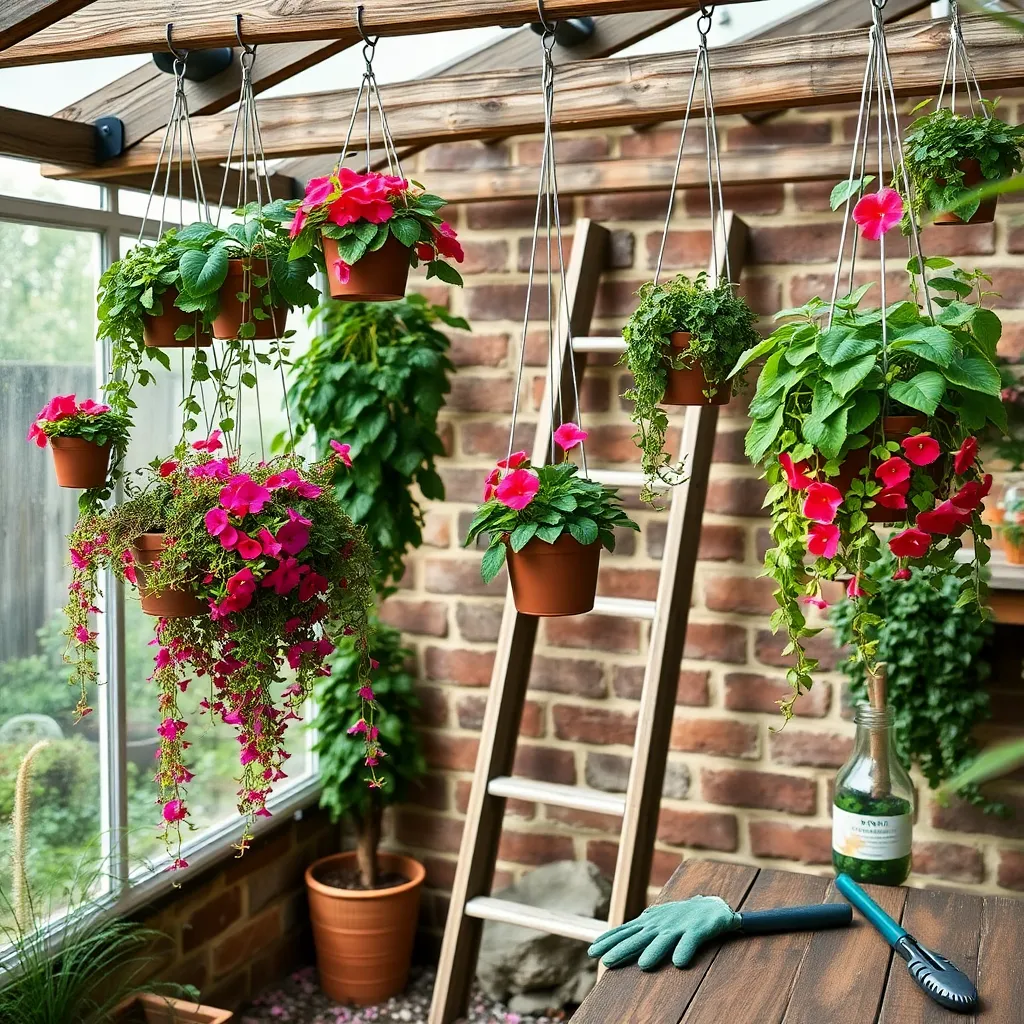
When installing hanging plants, it’s crucial to ensure the support structure is secure to prevent accidents. Use a stud finder to locate ceiling joists or wall studs, as these provide the most reliable support for your installations.
In addition to secure mounting, consider the weight of both the plant and the container. Lightweight materials like coco coir or plastic pots are excellent choices, and using a soil mix specifically designed for hanging plants can help reduce overall weight.
It’s important to choose the right hardware, such as heavy-duty hooks or brackets, to match the weight of your hanging setup. Regularly check these fixtures for signs of wear or damage to ensure continued safety.
Ensure that the placement of your hanging plants allows for easy access to water and care. Consider using a pulley system or adjustable hangers, which allow you to lower the plants for maintenance and then raise them back to their desired position.
Troubleshooting Common Plant Issues
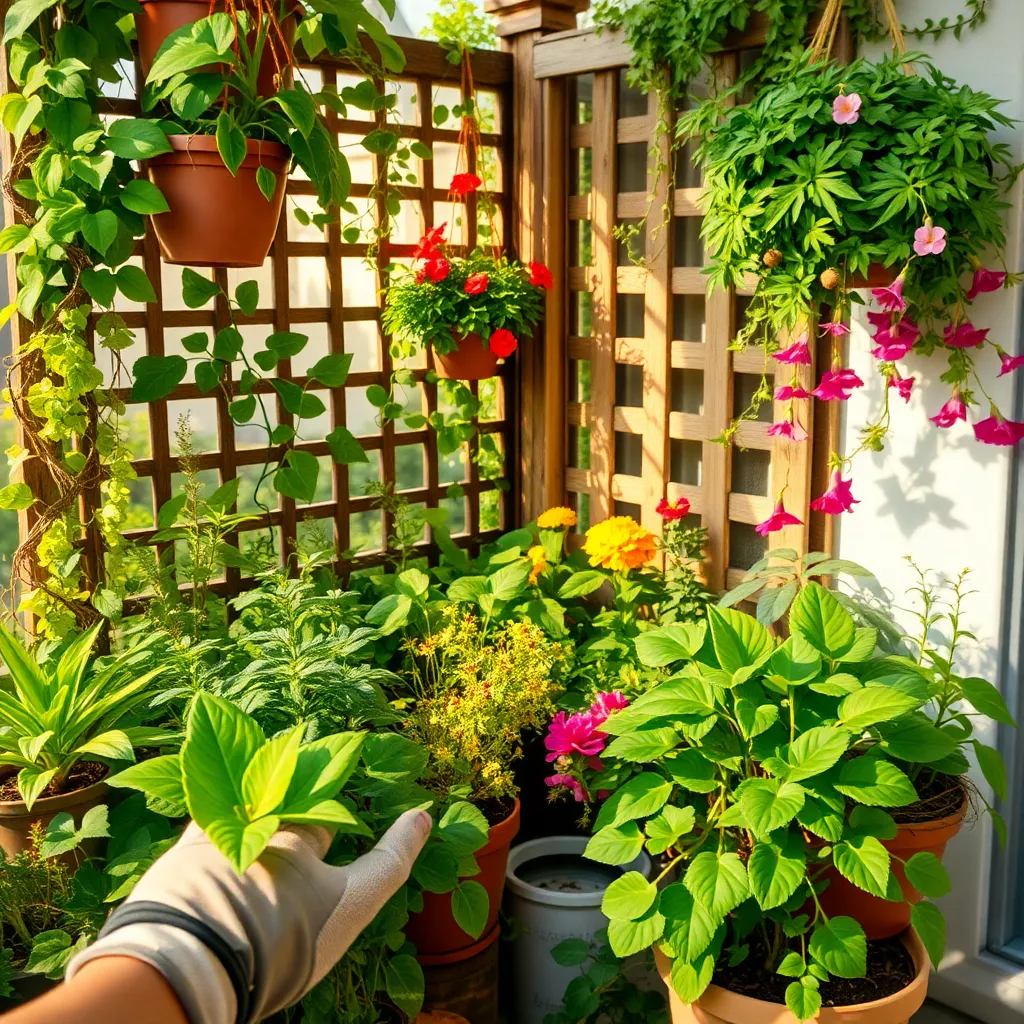
When it comes to hanging plants, one common issue is overwatering, which can lead to root rot. To prevent this, ensure your pots have adequate drainage holes and use a well-draining soil mix, like a blend of peat moss, perlite, and pine bark.
Another frequent problem is insufficient light, which can cause plants to become leggy and pale. Position your hanging plants in a spot where they receive the appropriate amount of sunlight; for instance, fuchsias thrive in partial shade, while petunias prefer full sun.
Pests can also wreak havoc on hanging plants, especially when they’re densely grouped. Regularly inspect your plants for signs of pests like aphids or spider mites and consider using an insecticidal soap or neem oil spray to keep infestations under control.
Additionally, temperature fluctuations can stress your plants, particularly if they’re near air conditioning vents or drafty windows. Aim to keep plants like begonias in a stable environment between 60-75°F to ensure vibrant growth and blooming.
Conclusion: Growing Success with These Plants
In exploring the vibrant world of hanging plants, we’ve uncovered 20 delightful ways to add color and life to your space while drawing insightful parallels to nurturing a thriving relationship. From the resilient adaptability of the Boston Fern to the exotic allure of the String of Pearls, each plant symbolizes a key relationship concept: patience, communication, growth, and mutual support. Just as these plants thrive with care and attention, so too can our relationships flourish with conscious effort and understanding.
As an immediate step, consider introducing a new plant into your home as a living reminder of the qualities you wish to cultivate in your relationship. Let it inspire you to nurture your connections with the same dedication.
Don’t let this treasure trove of relationship wisdom slip away. Save or bookmark this article now to revisit these concepts and refresh your perspective whenever needed. Remember, the journey to relationship success is ongoing, and with each small step, you’re one moment closer to deeper connection and shared happiness. Embrace the opportunity to grow, and watch as your relationships blossom alongside your vibrant, green companions.


